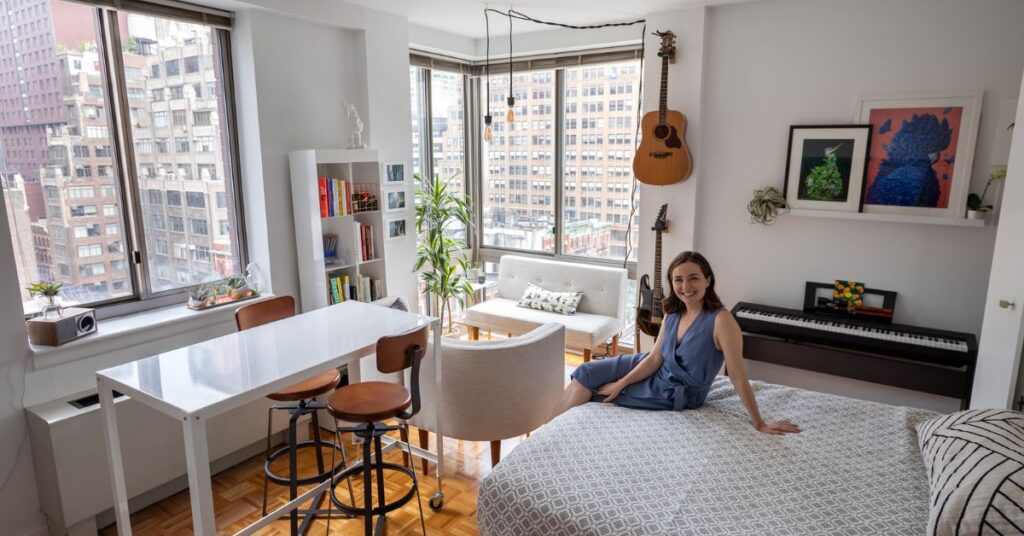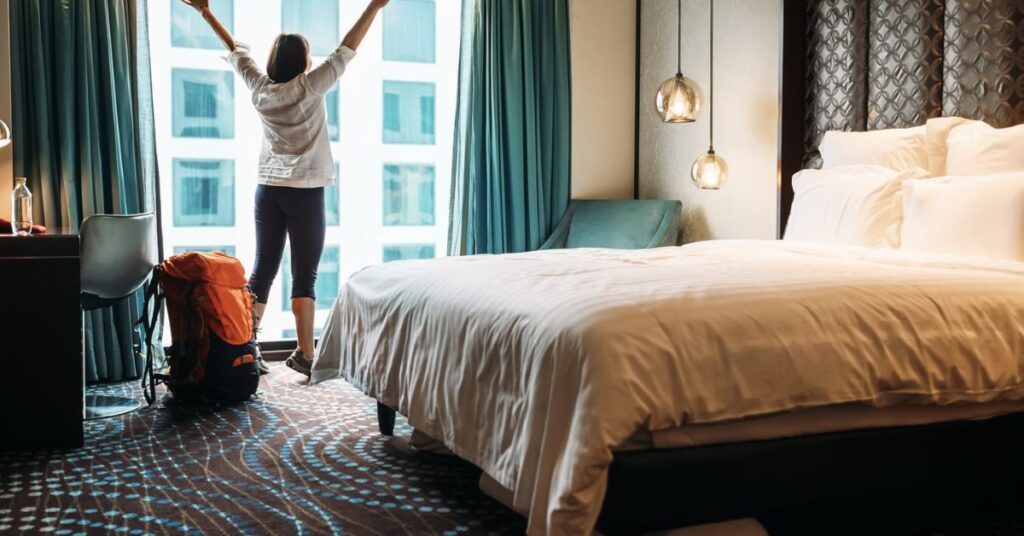One bedroom apartments offer convenience and affordability for many individuals or small families. Yet, it’s essential to consider various factors when determining the ideal number of occupants for such a space.
This piece delves into occupancy limits, exploring the factors influencing them and the consequences of overcrowding. It also offers practical tips for maximizing space within a 1 bedroom setup. Moreover, it touches upon the rights and responsibilities of both tenants and landlords, emphasizing the importance of suitable living conditions. So, let’s embark on a journey to uncover the intricacies of occupancy limits and their implications in the context of 1 bedroom apartments.
truly grasp the notion of occupancy limits
It’s vital to first comprehend its essence. Occupancy limits serve as a crucial framework dictating the maximum number of residents permissible in a dwelling, taking into account legal stipulations, health standards, and safety protocols. These limits aren’t mere arbitrary figures but rather meticulously crafted guidelines aimed at harmonizing the provision of livable space with the paramount concern for residents’ welfare. By striking this delicate balance, occupancy limits act as bulwarks against the pitfalls of overcrowding, which can precipitate a myriad of legal entanglements and practical challenges alike.
Occupancy limits are akin to carefully orchestrated symphonies, harmonizing the needs of inhabitants with the constraints of space and safety. They serve as guardians of equilibrium in the realm of residential living, meticulously balancing the allocation of space with the imperative of ensuring residents’ well-being. By adhering to these limits, we safeguard against the cacophony of overcrowding, fostering an environment where legal compliance and practical considerations intertwine seamlessly to nurture a habitat conducive to wholesome living.
Navigating the Legal Landscape of Occupancy Limits
When it comes to the legal framework surrounding occupancy limits, it’s all about adhering to local regulations and agreements. These guidelines, often shaped by building codes, rental contracts, or governmental zoning laws, carefully consider factors like dwelling size, bedroom count, and apartment layout.
For instance, in certain areas, there might exist a specific formula dictating maximum occupancy based on the apartment’s square footage, ensuring residents adequate living space for their comfort and well-being. Furthermore, rental agreements play a crucial role by outlining occupancy boundaries to prevent subletting or overcrowding, ultimately safeguarding the rights of both landlords and tenants and promoting a fair and harmonious living environment.
Considering health and safety factor
Apart from legal mandates, health and safety factors significantly influence the determination of occupancy limits in 1 bedroom apartments. Overcrowding poses various risks, including heightened fire hazards, compromised air quality, and constrained access to essential amenities.
Fire safety, in particular, emerges as a paramount concern. In the unfortunate event of a fire outbreak, overcrowded living spaces can impede residents’ swift evacuation, amplifying the likelihood of injuries or even fatalities. Establishing sensible occupancy limits is pivotal in ensuring ample space for residents to evacuate promptly and safely during emergencies, mitigating potential risks and safeguarding lives.Overcrowding exacerbates issues related to indoor air quality.
In cramped quarters, ventilation becomes a challenge, leading to stagnant air and an accumulation of pollutants. Such conditions pose a considerable threat, especially to individuals with preexisting respiratory ailments.Moreover, limited access to vital facilities like bathrooms and kitchens can foster unsanitary living conditions, further exacerbating health risks. By enforcing reasonable occupancy limits, authorities not only adhere to regulatory standards but also prioritize the creation of a safe and healthy living environment, where residents can thrive without compromising their well-being.
Elements Influencing Occupancy Thresholds
Occupancy thresholds are intricately influenced by a multitude of factors that govern the maximum number of individuals allowed in a dwelling. These factors, ranging from legal regulations to practical considerations, play a pivotal role in determining occupancy limits. Variables such as the size and layout of the apartment, the age demographics of its occupants, and the nature of their relationships all contribute to shaping these thresholds.
By carefully considering these elements, authorities can strike a balance between providing sufficient living space and ensuring the safety and well-being of residents. Thus, understanding the interplay of these factors is essential in establishing occupancy limits that promote comfortable and harmonious living environments.
Apartment Size and Its Impact
The size of an apartment is a fundamental factor that significantly influences its livability and occupancy limits. Larger apartments inherently offer more space, accommodating a greater number of occupants comfortably compared to smaller units. Building codes and regulations often stipulate minimum square footage requirements per occupant to ensure adequate living space and prevent overcrowding.
In densely populated urban areas where space is at a premium, such as bustling city centers, occupancy limits for 1 bedroom apartments may be more stringent to prioritize safety and well-being.The layout and design of the apartment also play a crucial role in determining occupancy limits.
Apartments with open floor plans and efficient use of space may be able to accommodate more residents compared to those with a more traditional layout. Additional rooms, such as separate living rooms or dens, may provide flexibility in accommodating occupants. However, irrespective of layout, authorities must balance the size and design of the apartment with the safety and comfort of its residents when establishing occupancy limits
Read it: Security Cameras in Rental Properties: Understanding Landlord and Tenant Rights
Age Demographics of Occupants.
The age demographics of occupants are pivotal in determining occupancy limits and the overall dynamics within a 1 bedroom apartment. Different age groups have varying space requirements and lifestyle needs, influencing the maximum number of individuals that can comfortably reside in such a space.
For instance, infants and young children typically require less living space compared to teenagers or adults. Housing regulations often take into account the specific needs of different age groups when setting occupancy limits to ensure adequate living conditions.
Additionally, factors such as the presence of elderly individuals or individuals with disabilities may necessitate adjustments to occupancy limits to accommodate their unique requirements and ensure a safe and inclusive living environment. Thus, understanding the age demographics of occupants is crucial in establishing occupancy limits that cater to the diverse needs of residents while promoting their well-being.
Tech Trendery aims to keep you informed. We cover the latest tech news and trends. Our goal is to make technology easy to understand. We break down complex topics into simple terms. This way, everyone can grasp the concepts.
We also provide tips and guides. These help you make the most of new technologies. Whether it’s a new app or a cutting-edge device, we’ve got you covered. Tech Trendery is your trusted companion in the tech world.
Interpersonal Dynamics Among Occupants

When it comes to sharing living spaces, the dynamics between roommates play a crucial role in determining the harmony and comfort within a 1 bedroom apartment. The relationship between occupants can range from being close friends to mere acquaintances, and this dynamic greatly impacts the overall atmosphere of the living environment.
Positive interactions, mutual respect, and effective communication can foster a sense of camaraderie and make cohabitation enjoyable. Conversely, conflicts, disagreements, or incompatible lifestyles can lead to tension and discomfort.
Therefore, establishing healthy interpersonal dynamics among occupants is essential for creating a pleasant and supportive living atmosphere where everyone feels valued and respected. Through open dialogue, compromise, and understanding, roommates can cultivate a positive living experience and build lasting friendships within the confines of their shared space.
Effects of Overcrowding
Overcrowding in living spaces can have pervasive effects that permeate through various aspects of daily life. Beyond the physical constraints of limited space, overcrowded environments often foster a sense of claustrophobia and discomfort among occupants.
The constant jostling for personal space can lead to heightened stress levels and strained relationships, as individuals struggle to carve out their own sanctuary within the crowded confines of the apartment.
Moreover, the lack of privacy in overcrowded settings can erode one’s sense of autonomy and mental well-being, contributing to feelings of anxiety and unease.
Overcrowding can exacerbate hygiene and sanitation concerns, posing risks to the health and safety of occupants.
With limited access to essential facilities like bathrooms and kitchens, maintaining cleanliness becomes a daunting task. Stagnant air and a higher concentration of pollutants in overcrowded spaces can also contribute to poor indoor air quality, increasing the risk of respiratory ailments and other health issues. In essence, the effects of overcrowding extend beyond mere inconvenience, impacting both the physical and psychological well-being of individuals sharing cramped living quarters.
Read it also: Bench Craft Company Lawsuit: Unveiling The Legal Battle
Optimizing Space in a One-Bedroom Living Space
The art of space optimization in your one-bedroom abode, transcending limitations for a comfortable living experience. Embrace multifunctional furniture and innovative storage solutions to make every corner count, enhancing the livability of your cozy dwelling. With strategic design choices, transform your compact space into a haven of functionality and comfort, unlocking its full potential.
Efficient Arrangement of Furniture
Strategically arranging furniture is key to maximizing space in a one-bedroom apartment. Incorporate multifunctional pieces like storage ottomans or convertible sofas to maximize functionality while minimizing clutter.
Designating specific zones for different activities, such as sleeping, working, and dining, creates a well-organized and efficient living environment. With careful planning and smart furniture choices, every corner of your one-bedroom apartment can be optimized for comfort and functionality.
Making the Most of Vertical Space
Harness the power of vertical space to expand storage and functionality in your one-bedroom apartment. Install wall-mounted shelves or hanging organizers to maximize storage without encroaching on floor space. With thoughtful utilization of vertical surfaces, you can enhance organization and create a visually appealing living environment.
Tenants’ and Landlords’ Rights and Responsibilities
Understanding the rights and responsibilities of both tenants and landlords is essential for fostering a harmonious living environment. Tenants have the right to a safe and habitable dwelling, while landlords are responsible for maintaining the property and addressing any necessary repairs. Clear communication and adherence to agreements ensure a mutually beneficial relationship between tenants and landlords, promoting a positive renting experience for all parties involved.
Responsibilities of Landlords to Ensure Suitable Living
Conditions

Landlords bear significant responsibilities in upholding suitable living conditions for their tenants. It’s their duty to maintain the property in a habitable state, ensuring it meets health and safety standards. This includes addressing any necessary repairs promptly and ensuring that essential facilities like plumbing, heating, and electrical systems are in working order. Additionally, landlords must provide adequate sanitation facilities and ensure proper waste disposal methods are in place to uphold cleanliness and hygiene standards. By fulfilling these obligations, landlords not only comply with legal requirements but also create a comfortable and safe living environment for their tenants.
Furthermore, landlords must adhere to rental agreements and local regulations regarding occupancy limits to prevent overcrowding and ensure residents have sufficient living space. They are also responsible for addressing any concerns or complaints raised by tenants regarding living conditions promptly. Regular inspections and maintenance checks can help landlords identify and resolve potential issues before they escalate, fostering a positive landlord-tenant relationship and promoting tenant satisfaction. Overall, by prioritizing the well-being and comfort of their tenants, landlords play a crucial role in creating a conducive living environment that enhances the overall renting experience.
Frequently asked question
What are landlords responsible for regarding maintenance and repairs?
Landlords are responsible for maintaining the property in a habitable condition, which includes ensuring that essential systems such as plumbing, heating, and electrical are in working order. They must promptly address any necessary repairs to uphold suitable living conditions for tenants.
Are landlords obligated to provide sanitation facilities and waste disposal methods?
Yes, landlords have a responsibility to provide adequate sanitation facilities and ensure proper waste disposal methods are in place. This includes ensuring that bathrooms are functional and that waste is disposed of appropriately to maintain cleanliness and hygiene standards.
How can landlords prevent overcrowding in rental properties?
Landlords must adhere to occupancy limits specified in rental agreements and local regulations to prevent overcrowding. By monitoring and enforcing occupancy limits, landlords ensure that residents have sufficient living space and can maintain a comfortable living environment.
What should tenants do if they have concerns about living conditions in their rental property?
Tenants should promptly communicate any concerns or complaints about living conditions to their landlord. Landlords are obligated to address these concerns in a timely manner and take necessary actions to rectify any issues to ensure suitable living conditions for tenants.
Conclusion
In conclusion, ensuring suitable living conditions in rental properties is a shared responsibility between landlords and tenants. Landlords have a duty to maintain the property in a habitable state, addressing any necessary repairs and providing essential facilities to uphold cleanliness and safety standards. By fulfilling these obligations, landlords create a conducive living environment that enhances the overall renting experience for tenants.
On the other hand, tenants play a crucial role in communicating any concerns or issues they encounter regarding living conditions, allowing landlords to take prompt action and resolve them effectively. By fostering open communication and cooperation between landlords and tenants, both parties can work together to create a positive living environment that promotes comfort, safety, and satisfaction.
Additionally, adherence to legal regulations and rental agreements is paramount to ensure compliance with occupancy limits and other requirements. By understanding and fulfilling their respective rights and responsibilities, landlords and tenants contribute to fostering a harmonious landlord-tenant relationship. Ultimately, by prioritizing the well-being and comfort of tenants, landlords can cultivate a positive reputation, attract quality tenants, and maintain the value of their rental properties over time.
Hey, Molar is the voice behind this all-encompassing blog, sharing expert insights and practical advice on business, real estate, and more. Dedicated to helping you navigate the complexities of these fields, Kelly provides the latest trends, in-depth analyses, and creative strategies to elevate your ventures.
